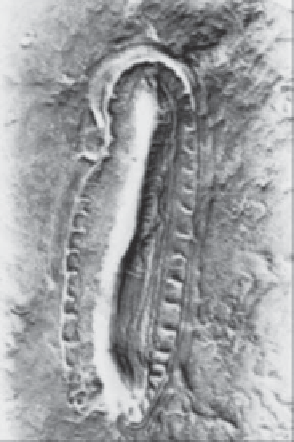Geology Reference
In-Depth Information
◗
Figure 19.26
Neoproterozoic Fossils
b
These small branching tubes
from China may have been made by
early relatives of corals. The tubes
measure 0.1 to 0.3 mm across.
a
These fossils from Newfoundland have not been given scientifi c names. The one at the upper center
is called a
feather duster
, whereas the other fossils are called
spindles
.
Banded iron formations (BIFs), the world's major source of
iron ores, are present on all continents, and 92% of all BIFs
were deposited during the Paleoproterozoic (Figure 19.16).
China, Brazil, and Australia, in that order, are the larg-
est producers of iron ore. The United States must import
about 30% of the iron ore it uses, mostly from Canada and
Venezuela. Most of the iron ore mined in North America
comes from mines in the Lake Superior region and in eastern
Canada (see Geo-Focus on page 519).
The Sudbury mining district in Ontario, Canada, is an
important area of nickel and platinum production. Nickel is
essential for the manufacture of nickel alloys such as stainless
steel and Monel metal (nickel plus copper), which are valued for
their strength and resistance to corrosion and heat. The United
States imports more than 50% of all the nickel it uses, most
from the Sudbury mining district in Canada. Some platinum for
jewelry, surgical instruments, and chemical and electrical equip-
ment is also exported from Canada to the United States, but the
largest exporter is South Africa. The United States also depends
on South Africa for much of its chromite, the ore of chromium.
The 2.0-billion-year-old Bushveld complex in South Africa
is a huge layered igneous body with rich ores of chromium,
platinum, and several other metals. It probably originated as
multiple intrusions of magma that slowly crystallized so that
different minerals were concentrated in nearly horizontal layers.
Economically recoverable oil and natural gas were dis-
covered in Proterozoic rocks in China and Siberia, arous-
ing interest in the Midcontinent rift as a potential source of
hydrocarbons. Some rocks within the rift are known to con-
tain oil, but so far no oil or gas wells are operating.
c
All agree that
Kimberella
from Russia was an animal; some think
it was a mollusk. Specimens measure 3 to 10 cm long.
with crystals and settled in mafic and ultramafic plutons.
The Stillwater Complex in Montana has low-grade chrome
and platinum ores that have been mined and stockpiled dur-
ing the past, but so far they have not been refi ned for their
chrome or platinum.
Archean-age pegmatites are mostly granitic and of little
economic importance. However, some in Manitoba, Canada,
and the Rhodesian Province in Africa contain valuable min-
erals. In addition to gem-quality minerals, a few Archean
pegmatites are mined for lithium, beryllium, and rubidium.




Search WWH ::

Custom Search